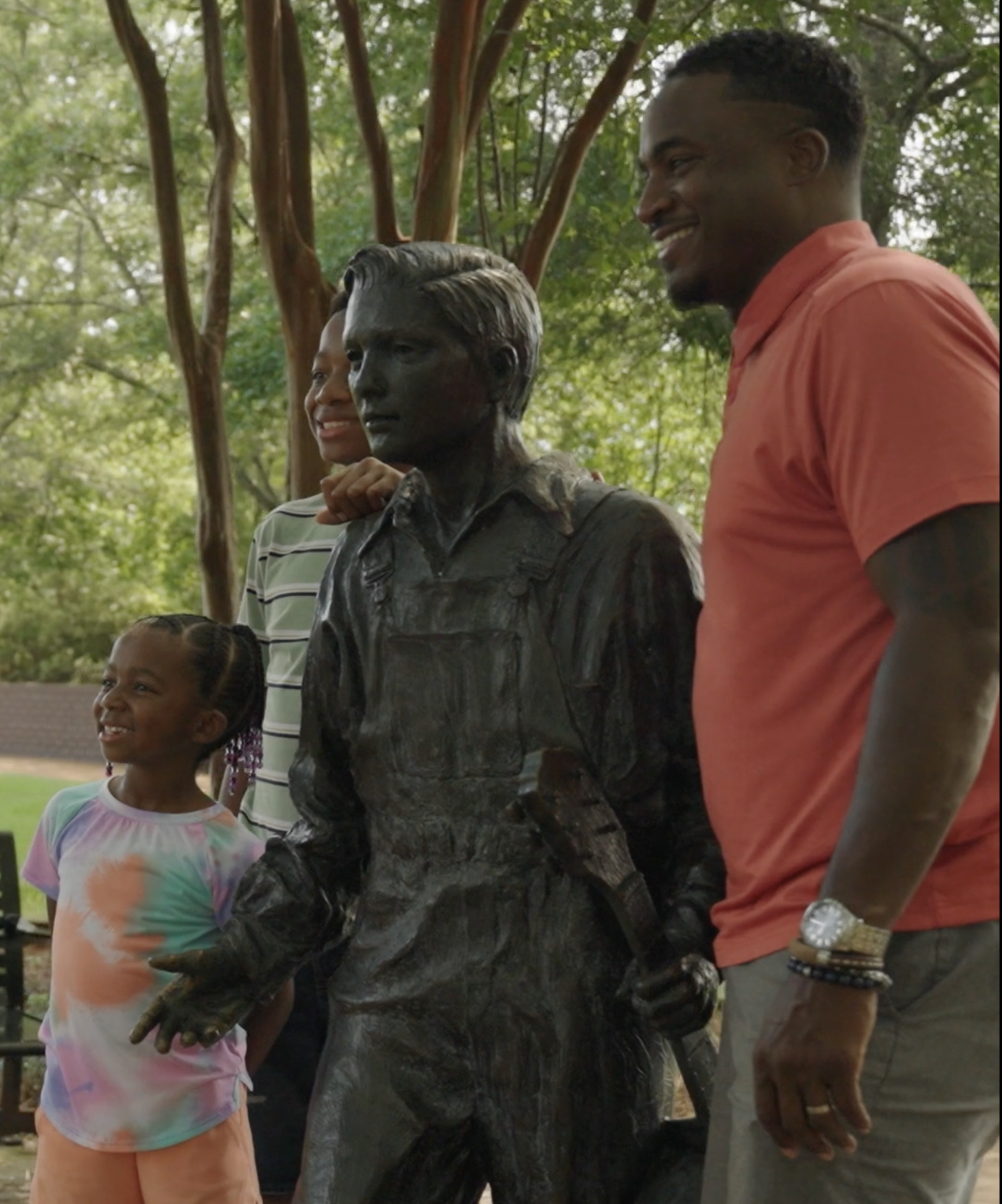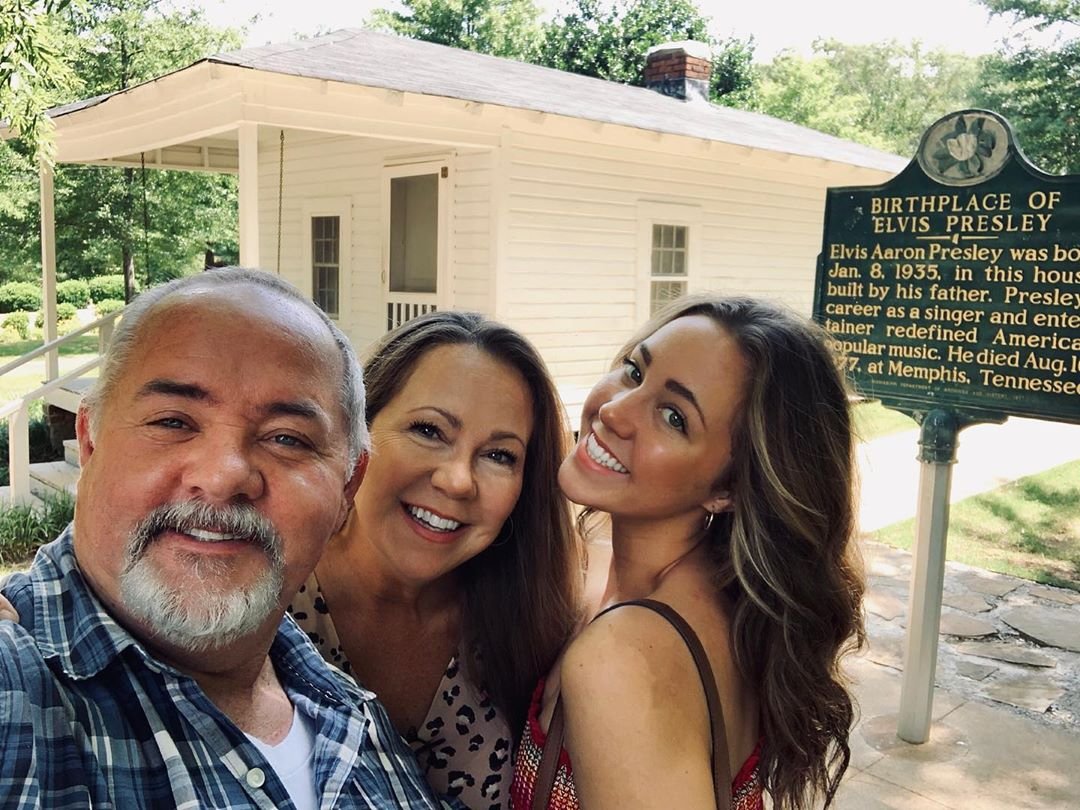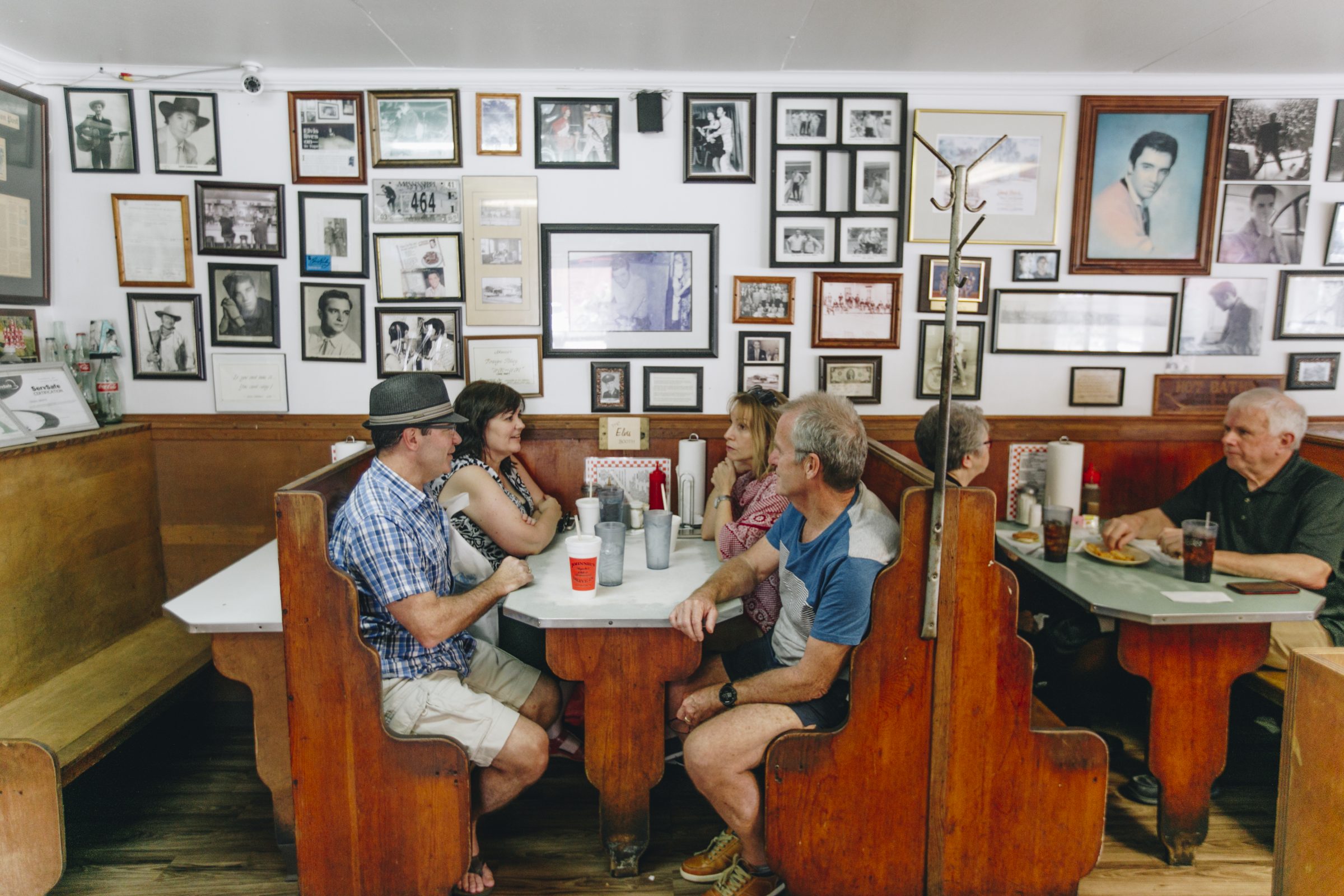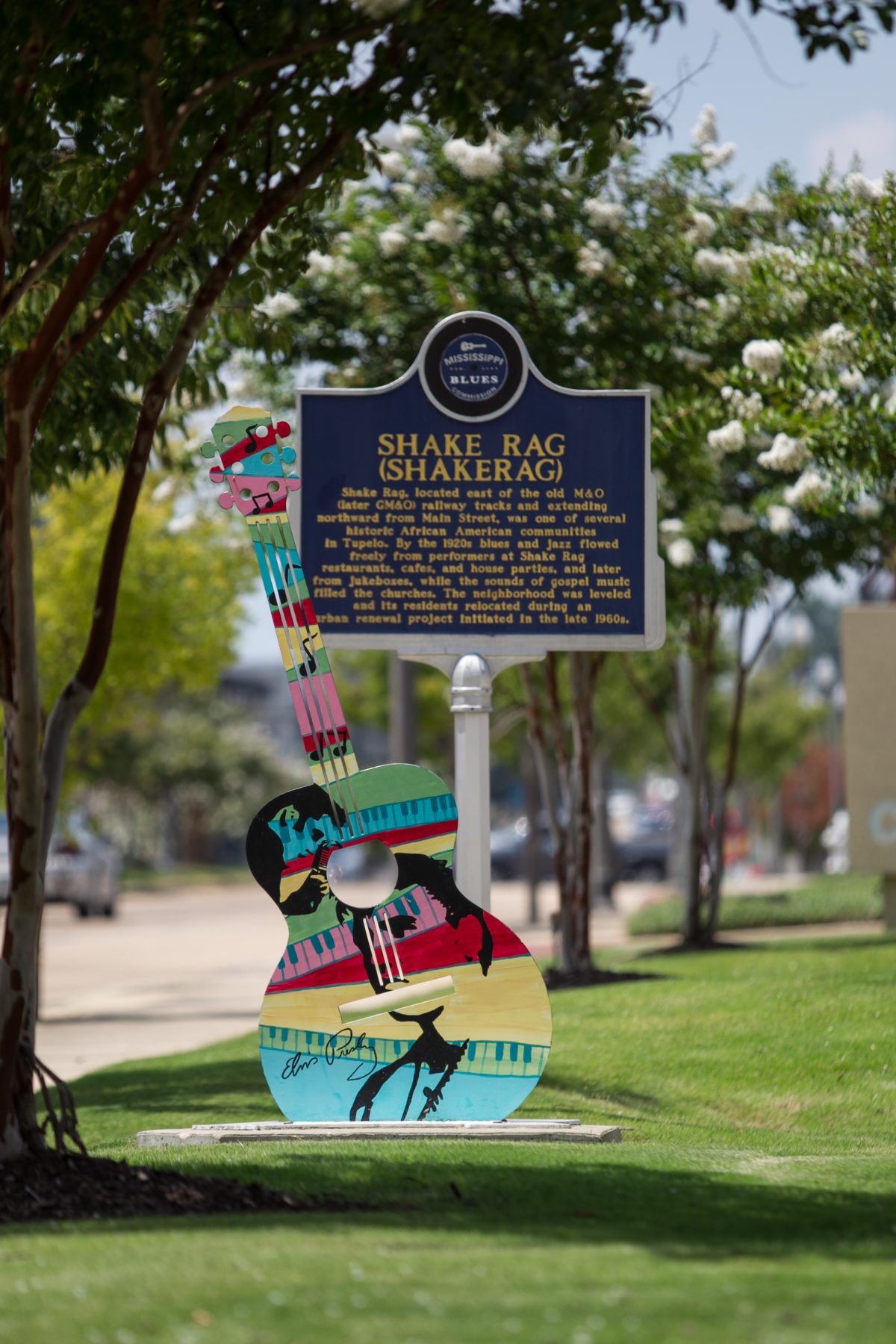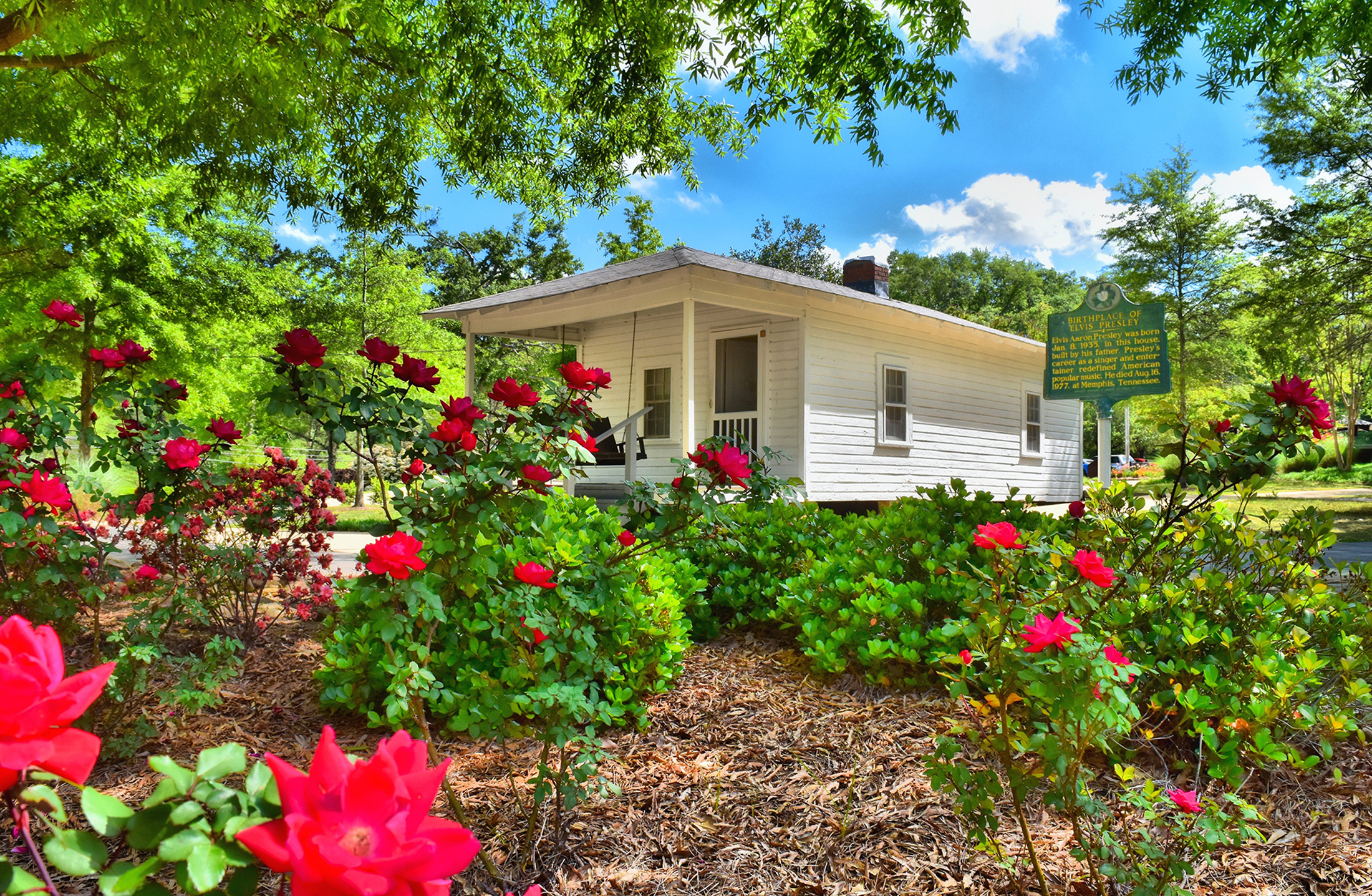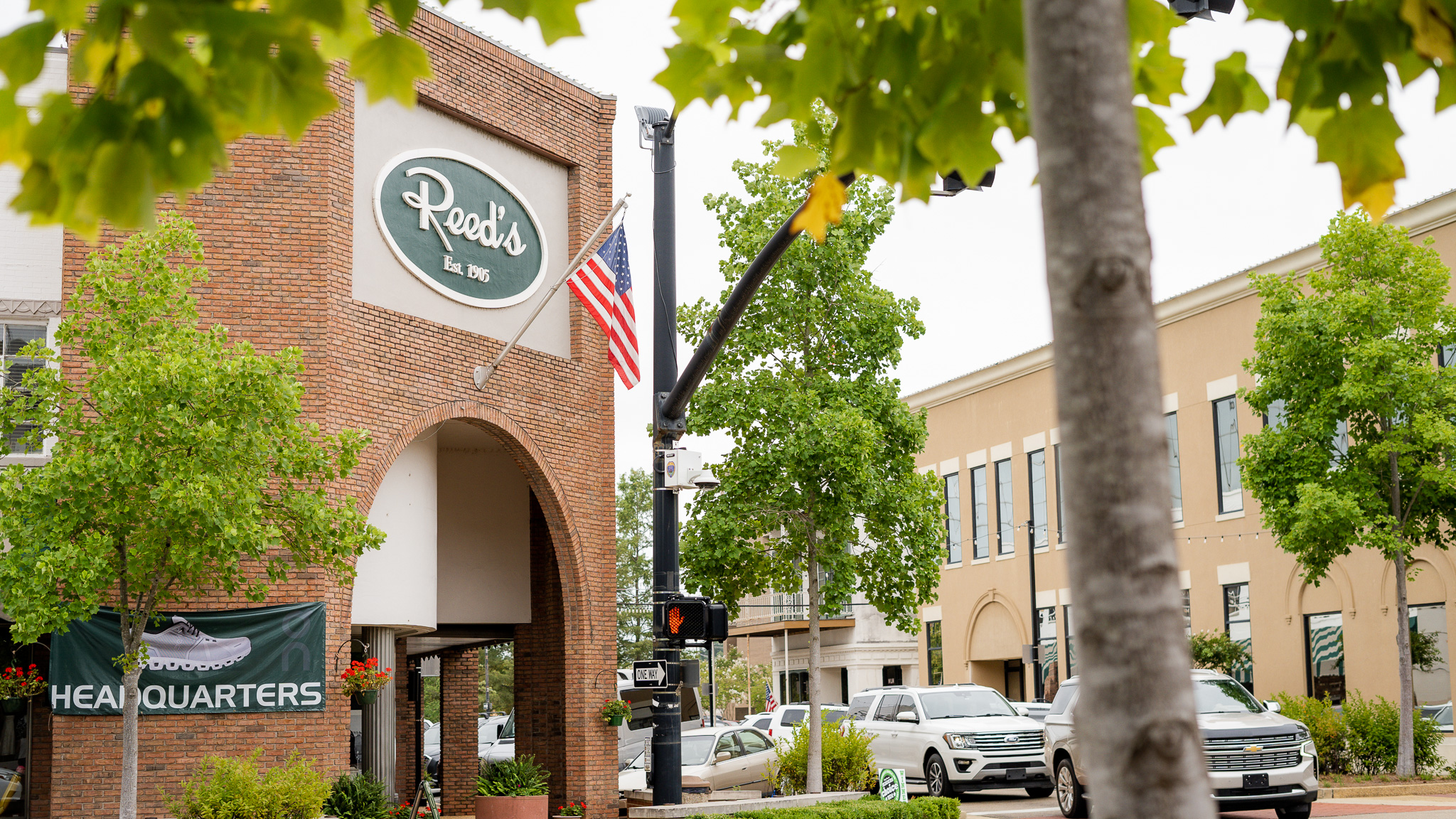“Tupelo, birthplace of Elvis Presley and the seventh-largest city in Mississippi, is located in northeast Mississippi between Memphis, Tennessee, and Birmingham, Alabama. The seat of Lee County, Tupelo had a population of 34,211 as of the 2000 census. Tupelo is a three-time “All-American City Award” winner and boasts one of the largest furniture-manufacturing industries nationwide.”
— Wikipedia
Incorporated in 1870, Tupelo — originally called Gum Pond, on account of the sweet gum trees that proliferated in the region — quadrupled in size after a well-placed railroad crossing brought commerce to the town after the Civil War. It flourished throughout the 20th century, thanks to the cheap electricity provided by the Tennessee Valley Authority and the fortuitous intersection of two major U.S. arteries, interstate highways 78 and 45. Despite the 1936 Tupelo tornado, the fourth-worst tornado in American history, the town proved to be an ideal place to live for working-class people on their way up the economic ladder.
As Tupelo flourished, however, East Tupelo — located, literally, “across the tracks” — gained a reputation as a den of iniquity. Driving through the region in the 1930s, gangster Clyde Barrow and his gun moll Bonnie Parker holed up there for a few days, making their home among the bootleggers, prostitutes, and ne’er-do-wells who provided a variety of services for the factory workers who shunned the city lights of Tupelo proper.
If you were saddled with an East Tupelo address you were considered “poor white trash.” Decent Tupelo residents guarded their wallets, their businesses, and their daughters from these roughneck counterparts whenever they ventured into town.
Today, to an out-of-towner — even, say, a visitor from Memphis — any distinctions between Tupelo and East Tupelo are nearly imperceptible. The two officially merged in 1946. They both boast sprawling avenues of fast-food restaurants, brick school buildings and green playing fields, churches, and neighborhood after neighborhood of modest, single-story abodes. Yet among the older locals, some “otherness” still prevails, and social lines remain well defined. Between graduates of the Church Street Elementary School, lauded as an ideal educational facility at the 1939 World’s Fair, and alumni of the grittier East Tupelo Consolidated School, located a few miles — and a world — away, the differences are most apparent.
Despite the opportunities afforded the scholars who lingered in Church Street Elementary’s beautiful, modern classrooms, a singular East Tupelo student overshadows them all: Elvis Aron Presley, born by the light of an oil lamp in a shotgun shack on Old Saltillo Road, in the heart of the East Tupelo community.
Today, Presley’s January 1935 birth — and that of his stillborn twin, Jesse Garon, who arrived first — is the stuff of legend. Dozens of tomes document the nativity with saintlike fervor, while Australian singer Nick Cave detailed the myth in a spooky song called “Tupelo”: “Saturday gives what Sunday steals/And a child is born on his brother’s heels/Come Sunday morn the first-born is dead/In a shoebox tied with a ribbon of red/God help Tupelo.”
From the perspective of any prosperous, post-Depression-era resident, however, the arrival of another hungry mouth in East Tupelo was hardly an occasion to remember. Elvis, the son of Vernon Presley, a day laborer who served time at Parchman Penitentiary for forging a check, and Gladys Smith Presley, a 16-cents-an-hour employee of the Tupelo Garment Plant, managed to escape attention until the fall of 1945, when he was 10 years old.
In October, Gladys and Elvis attended the Mississippi-Alabama Fair and Dairy Show, held at the downtown fairgrounds. The annual event drew both the haves and have-nots of the region. Anyone who possessed a clean shirt and two cents to rub together could go to the fair. Wednesday, October 3rd, was Children’s Day, and the kids of East Tupelo Consolidated were welcomed right alongside the bluebloods of Church Street Elementary. That day, most of the children were content to eat themselves sick on cotton candy and shriek till they were hoarse on the midway rides, but Elvis outdid everyone by entering a radio talent contest sponsored by WELO. Wearing his overalls, the fifth-grader sang “Old Shep” in front of several thousand people and took fifth place.
Fast-forward 11 years, when the Presleys were living in Memphis, and Elvis’ star was on the rise. He had “That’s All Right (Mama)” and “Blue Moon of Kentucky” under his belt, along with his early RCA hits, “Hound Dog,” “Don’t Be Cruel,” and “Heartbreak Hotel.” Backed by guitarist Scotty Moore, bassist Bill Black, and drummer DJ Fontana, he’d performed at the Louisiana Hayride and appeared on national TV shows like The Milton Berle Show, The Steve Allen Show, and The Ed Sullivan Show.
In August 1956, Elvis began production on his first motion picture, Love Me Tender. On September 26th, he returned to Tupelo a bona fide celebrity.
According to Elvis biographer Peter Guralnick, the Presleys drove the 108 miles from Memphis to Tupelo in a white Lincoln, arriving on Main Street, which was decorated with “Tupelo Welcomes Elvis Presley Home” banners, in mid-afternoon.
“I’ve been looking forward to this homecoming very much,” Elvis told reporters upon his arrival. “I’ve been escorted out of these fairgrounds when I was a kid and snuck over a fence, but this is the first time I’ve been escorted in.”
Marching bands, baton twirlers, Mississippi governor J.P. Coleman, Tupelo mayor James Ballard, and 50 members of the National Guard were on hand for Elvis’ afternoon and evening concerts, attended by thousands of curiosity-seekers and a bevy of hysterical teenage girls.
“It was my senior year in high school that summer,” remembers Tupelo resident Sara Ann Gunter, who lived in nearby Verona at the time, “and I worked in a photography studio that was owned by James Kingsley, who was The Commercial Appeal correspondent in the area. When I heard that Elvis was coming to Tupelo, I badgered that poor fella all summer long to get me backstage so I could meet him.
“Elvis more or less lived on the wrong side of the tracks, and the Presleys were desperately poor, so it must’ve been tremendous to have the whole town turn out for a parade and a concert and to receive the key to the city,” she says.
Sometime between the afternoon and evening performances, Gunter posed for photos with Presley. “I presented him with one of his souvenir hats, and then he kissed me,” she says. “What a thrill … I was the envy of all my classmates! It was the highlight of my life. I kept that outfit on until the moths ate it up, and my husband says that I haven’t washed my face since.”
Not long afterward, pictures of Gunter and Presley popped up in fan magazines, and she began receiving fan mail. “People thought I knew Elvis on a personal basis,” she marvels. “For a little high school girl, that was just amazing!”
“We were on the road so much in those days, but I do remember that Elvis was nervous when we got to Tupelo,” Scotty Moore recalls. “His mother and daddy were there, and I’m sure he saw a lot of people that he hadn’t seen in a long time. We all kept pretty busy. It sure was hard fending off all those females.”
“That homecoming meant everything,” Guralnick says. “He was embraced by his hometown, and the fact that his parents were there to see him be recognized by the mayor and the governor meant even more. The Presleys came from a scorned part of the community — East Tupelo was not Tupelo,” he reiterates. “Regardless, community was very important to Elvis. After all, he’s the guy who never left Memphis.”

Filmmaker Mike McCarthy sits in Otherlands Coffee Bar in Midtown Memphis, describing from memory a pair of photographs shot at the ’56 Tupelo fair, seven years before he was born.
“Roger Marshutz’s photograph of Elvis’ hand reaching out toward his fans is so ‘God and Man,’ so elitist,” he proclaims. “Look at Terry Wood’s interpretation of the same scene, which is more populist. You see Elvis, the crowd, the band, and everything.”
McCarthy knows both images well. His birth mother — an East Tupelo resident named Barbara Westmoreland, just 15 years old at the time of the concert — was somewhere in the gaggle of girls crowding the stage, while his adoptive parents stood in the back row. He’s scrutinized these photos for decades, searching for clues about his anonymous father.
“I’m Tupelo’s least-favorite son,” McCarthy says, “given away to the people in the cheap seats.
“It’s a divine enigma,” he adds, taking another sip of coffee.
Twelve years ago, he filmed Teenage Tupelo, a pseudo-autobiographical sexploitation romp, as part of his quest for the truth. In the self-produced, feature-length movie — filmed on a Super 8 camera for $12,000 — red-headed ingénue D’Lana Tunnell plays McCarthy’s birth mother, whom he’s never met, as the definitive rock-and-roll heroine. Self-appointed starlets Dawn Ashcraft (McCarthy’s real-life wife, Kim McCarthy), Kristen Hobbs, and Sophie Couch portray members of a tough girl gang. Wanda Wilson, Hugh Brooks, garage band Impala, and musicians Greg Cartwright and Jack Yarber round out the cast.
While Teenage Tupelo employs Jungian precepts to hype the mythology of Presley’s birth, the destructive swath cut by the Tupelo tornado, and the possible whereabouts of Jesse Garon’s unmarked grave, fundamental details from McCarthy’s own life ultimately shine through.
“It’s an adoption saga,” he claims. “Since I have no family history, I’ve had to create it. Even though it’s partially fantasy, Teenage Tupelo is my history.”
McCarthy knows that Presley probably isn’t his father. “I think he was more likely Warren Smith, Jumpin’ Gene Simmons, or Hayden Thompson,” he says, listing other rockabilly musicians who played the east Mississippi circuit and recorded in Memphis at Sun Studio — coincidentally, McCarthy’s employer for the last three years.
“They were all guys singing about premarital sex, and apparently, my mother was available. She didn’t get married until her third pregnancy, ” he states.
“I feel like she was a teenage Tupelo. She was definitely caught up in that rockabilly world. She was probably curious like I’m curious, and she probably had questions that went unanswered. I’ve always thought about how rebellious and delinquent she was and how desperate she must’ve been, being a creative person stuck in East Tupelo.
“But why did she get pregnant [out of wedlock] twice?” McCarthy asks, explaining that his birth mother kept her first child and her third, giving only him — her second son — away.
McCarthy and a friend, Darin Ipema, maxed out their credit cards to shoot Teenage Tupelo in the summer and fall of 1994. “The Tupelo Film Commission had no idea we were filming, and they never caught up with us,” he says. “We didn’t ask permission, and on a few occasions when the cops showed up, we denied everything.”
Their footage features several Presley landmarks, including the Tupelo Hardware Store (where Gladys bought Elvis his first guitar), the Lyric Theater, and, of course, the fairgrounds, which had fallen into a state of disrepair.
“Making the movie was fun,” McCarthy says, noting that his adoptive mother, Mildred McCarthy, who has a cameo in the flick, died before it was done. “It was the kind of thing that changes you forever.”
East Tupelo native Roy Turner and his best friend, Jim Palmer, have been laboring for months on Homecoming, their documentary of Presley’s 1956 Tupelo fair performance, which will debut at the Lyric Theater this weekend as part of the 50th anniversary of Elvis’ homecoming and the town’s eighth annual Elvis Festival.
“Jim and I both grew up in East Tupelo. My dad worked with Gladys at the shirt factory,” Turner relates. “We came from similar economic backgrounds as Elvis. We’ve watched several people make documentaries about Elvis, and we’ve helped many authors with their Elvis books. Elaine Dundy, who wrote Elvis and Gladys, awakened us to the idea. When she came here from London, in 1981, she taught us to look in our own backyard and appreciate the story that was already around us.”
Despite the proliferation of Presleyana, Turner says that, until now, Elvis’ Tupelo performances have garnered scant attention from the mainstream media. “Both the 1945 talent show and the ’56 fair were pivotal moments in his life,” says Turner, “yet everyone passed over them with a page or two.
“Every entertainer has a year, and 1956 was Elvis’ year,” Turner says. “He’d appeared on national TV, and he’d signed his movie contract. He had two million-selling records. To be from the wrong side of the tracks and to return with his parents to the town where they’d never been people of any importance must have been a tremendous moment.”
Turner and Palmer interviewed three participants from the 1945 talent contest, several employees of sponsoring station WELO-AM 580, Sara Ann Gunter, and nine girls who stood in the front row of the ’56 performances. They scanned hundreds of photos from both events, half of which have never been seen before, discussed details of the concerts with Scotty Moore and D.J. Fontana, and explored the impetus behind Presley’s return visit a year later, when he donated a chunk of cash for a youth center in East Tupelo.
“I attended my first dance at that youth center,” Turner proudly notes, even as he admits that it took the city the better part of a decade to build the facility.
“Elvis was hurt when they turned their backs on him and didn’t immediately use his money,” acknowledges Guralnick. “My guess today is that it was a class prejudice, which really stung. It must’ve hurt terribly that after the reception in Tupelo in ’56, which was a gesture of pure generosity, people treated him this way a year later.

“Elvis never turned his back on Tupelo,” Guralnick adds. “He was proud. Well into the ’70s, he would take people down to Tupelo to show them where he was from, and he always spoke about it in the narrative of his life.”
McCarthy — who’s gone on to make films like Superstarlet A.D., The Sore Losers, and E*vis Meets the Beat*es — says that Teenage Tupelo premiered in Paris, France, in May. He’s seeking backers to finance a double-DVD edition of the movie, which he plans to release in September. And he’s ever hopeful that one day, he’ll screen it in Tupelo, as part of the Elvis Festival or the Tupelo Film Festival, held at the Lyric Theater every spring.
“Is Tupelo ready for Teenage Tupelo?” he wonders, his eyes twinkling. “After we finished our movie, they tore down the fairgrounds to build a new city hall, which looks like something Wal-Mart might slap up. It was a short-sighted move. They could’ve sold the fairgrounds wood for a million bucks on eBay.
“If they really think of Elvis as a native son, they should rebuild the fairgrounds like Memphis did Stax,” he declares. “Otherwise, it’s just lip service.”
McCarthy continues to plot a meeting with his birth mother, who works in Tupelo. “I can’t believe she’s not curious about her grandchildren,” he muses.”I’ve had one brief phone conversation with her, and I’m acquainted with two of my half-brothers, but she still won’t tell me who my father is. She said she’d take the secret to her grave.”
Even today, nearly 29 years after his death, Presley’s relationship with the city of Tupelo remains complex.
“We wanted to tell a happy story with our documentary. It’s a totally positive film,” says Turner. “Elvis had such an impact that Tupelo couldn’t ignore him. But in all honesty, he got so big so fast, it’s almost as though his success was forced upon the town.
“When Elvis died,” he reveals, “his birthplace had to be saved from falling down by a group of retired school teachers who belonged to a garden club. It wasn’t until money started to suddenly pour in from all over the world that the city realized what an asset they had.
“The festival has never quite pulled the crowd we hoped it would,” Turner says. “Hopefully, that will change this year.”
“I’m real anxious to see Roy’s documentary,” Gunter says, “and I’m looking forward to seeing [Elvis impersonator] Travis LeDoyt. He looks very much like Elvis did back then, and, if you close your eyes, you can almost believe you’re actually hearing him.”
